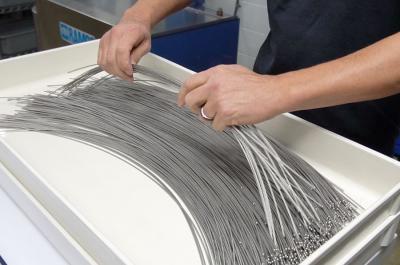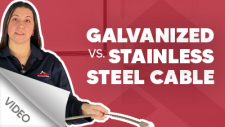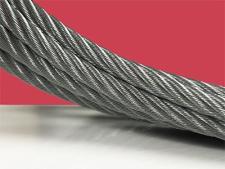Stainless steel mechanical cable is, by its very design, corrosion resistant. Even setting aside mechanical cable for a moment, stainless steel, as a material choice in any use case, ensures impressive resistance to environmental elements that would corrode this popular iron and carbon alloy. However, for all its corrosion-resistant properties, even stainless steel remains at risk of oxidation when applied to a harsh environment. It is therefore precisely when stainless steel requires additional protection from hostile conditions that cable design engineers may choose to perform an operation known as passivation to the stainless steel cable.
What is Passivation?
Passivation extends the life and quality of a stainless steel cable (and/or wire rope) by maximizing its corrosion resistance. This maximizing process involves treating the surface of the stainless steel mechanical cable with either nitric acid or citric acid, which removes free iron from the cable filament surfaces themselves. The acid removes the iron particles that exist on the surface layer of the cable, which may cause oxidation if certain conditions are present. Without passivation, by way of comparison, the free iron in the stainless steel cable would react with the oxygen in the air to ultimately introduce rust to the cable. Passivation removes this unwanted iron, leaving the critical element chromium to act as the protectant against oxidation.
Once the passivated cable is then exposed to oxygen, the oxygen bonds freely with the surface, creating an oxide layer that inherently protects the cable. The oxygen now binds to the surface instead of oxidizing. So the once potentially hostile and harmful element oxygen is now free to make unfettered contact with the stainless steel cable without consequence.
However, as protected as passivation leaves stainless steel cable, engineers must still treat the cable with care. Passivation creates a microlayer of protection against corrosion, but this surface treatment can be inadvertently stripped by the presence of friction, or other surface penetrant. So when installing, for instance, passivated stainless steel cable into a motion control system, design engineers must mitigate any potential sources of unwanted friction or other types of damage to the surface of the cable itself.
The Passivation Procedure
When passivating stainless steel cable, the cable is first cleaned through a process known as ultrasonic cleaning. Ultrasonic cleaning is the process of literally bathing the stainless steel cable in a solution where high frequency vibrations resonate the cable. These vibrating forces effectively shake free any unwanted particulate in anticipation of the passivation process.
Because passivation is designed to increase corrosion resistance to the surface of the cable filaments, it’s critical to understand that the role of ultrasonic cleaning is therefore to expose the most amount of cable surface area possible to later passivate. Once the stainless steel cable is ultrasonically cleaned, passivation can begin.

Can All Cable Materials be Passivated?
Although stainless steel cable is ideally suited to passivation, the acid used and degree to which the cable is exposed to it is determined by the grade of stainless steel. 304 stainless steel, for example, has a 18% chromium content, whereas 316 has 16% of the same element. Because of this subtle difference in material components, each will tolerate passivation acids differently. So while passivation is ideal for stainless steel, the acids used, as well as the exposure to them is decided on a case-by-case basis.
But what other cable materials are suited to the passivation process?
Take tungsten cable, for instance. It is not necessary for tungsten mechanical cable to be passivated because wolfram does not contain free iron. Remembering that it is the presence of free iron that puts stainless steel cable at risk of corrosion, wolfram simply does not possess the same molecular components and thus, the same risks.
If tungsten was dipped in passivating acids, by way of comparing it to stainless steel cable, it might erode the material to the detriment of its strength and integrity.
What’s more, galvanized steel cable likewise does not require passivation because galvanized cable, by design, contains an added layer of zinc. This protective layer of elementary material provides comparable oxidation resistance for galvanized steel cable that’s similar to that which is achieved with passivated stainless steel cable.
Markets Best Served with Passivated Stainless Steel Cable
The marine industry, as well as the food industry, are ideal candidates to use stainless steel cable that has been passivated.
These industries generally possess moisture-rich environments that put stainless steel cable in danger of corrosion were it not passivated. Moreover, anywhere oxygen is present, stainless steel cable performs best when passivated.
Advice To Engineers
Passivation does not affect the structural integrity of the stainless steel because the process only affects a negligible amount of surface material. When in doubt, consult your cable design engineer to ensure that the cable application under consideration requires or benefits from passivation.
Sava possesses decades of in-house engineering, quality and production expertise to accommodate any stainless steel passivation project. Contact us for more information about cable passivation.






